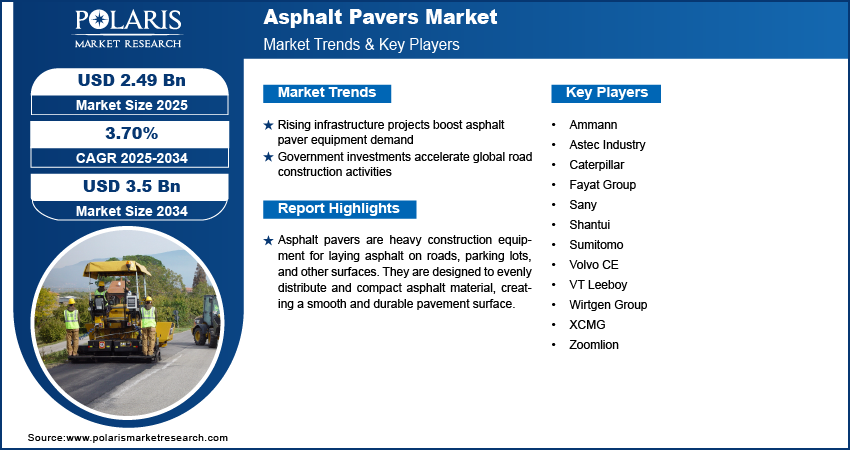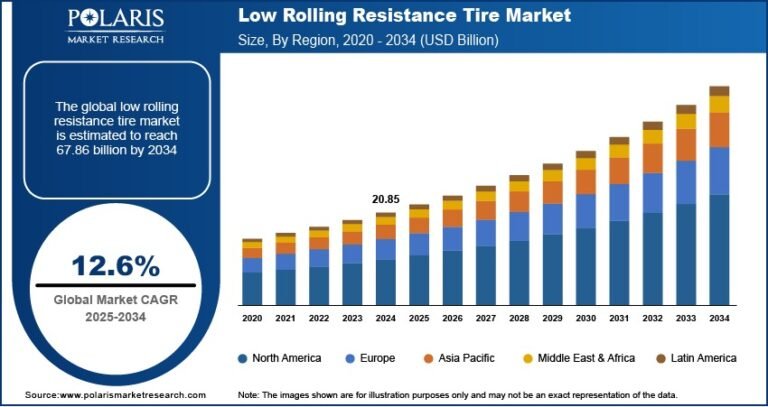Asphalt Pavers Market Projected to Reach USD 3.5 Billion by 2034, Growing at a CAGR of 3.70%

The global asphalt pavers market was valued at USD 2.4 billion in 2024 and is projected to expand at a CAGR of 3.70% from 2025 to 2034, driven by increasing road construction projects and ongoing infrastructure development worldwide.
Key Market Trends & Insights:
- Surge in Road Construction Projects: Rapid urbanization and infrastructure development driving demand for modern paving equipment.
- Adoption of Automation & Smart Technologies: Integration of GPS, telematics, and automation for enhanced precision and efficiency.
- Focus on Sustainability: Use of eco-friendly asphalt mixtures and fuel-efficient machines gaining traction.
- Growth in Highway & Expressway Expansion: Government investments in large-scale transportation networks fueling market growth.
- Rental Equipment Market Expansion: Increasing use of leased pavers by contractors to reduce capital costs.
- Technological Upgrades in Paver Design: Advancements in screed control systems and electric drive solutions improving performance.
- Rising Demand in Emerging Economies: Infrastructure modernization in Asia-Pacific and Latin America creating new growth opportunities.
Market Size & Forecast
- Market size value in 2025 – USD 2.49 billion
- Revenue forecast in 2034 – USD 3.5 billion
- CAGR – 3.70% from 2025 – 2034
Request for Free Sample: https://www.polarismarketresearch.com/industry-analysis/asphalt-pavers-market/request-for-sample
Market Challenges: Asphalt Pavers Market
- High Initial Investment and Maintenance Costs – Asphalt pavers require substantial upfront capital, and ongoing maintenance can be costly, especially for smaller construction firms operating on tight budgets.
- Volatility in Raw Material Prices – Fluctuating prices of key inputs like bitumen and steel impact manufacturing costs and profitability, making long-term planning difficult for market players.
- Skilled Labor Shortage – Operating advanced paving equipment demands trained personnel, and the shortage of skilled operators in many regions can limit the efficient use of asphalt pavers.
- Stringent Emission Regulations – Increasing environmental regulations around emissions and noise pollution force manufacturers to invest in cleaner technologies, increasing R&D and production costs.
- Infrastructure Funding Gaps – Inconsistent government funding and delays in infrastructure development projects, especially in developing economies, hinder the steady demand for asphalt paving equipment.
Market Segmentation:
The asphalt pavers market is segmented across several key categories to analyze its structure and growth trends effectively:
- By Type: Includes tracked pavers and wheeled pavers. Tracked pavers dominate due to their superior traction and performance on uneven surfaces, while wheeled pavers are preferred for urban and road maintenance applications.
- By Paving Width: Segmented into less than 2.5 meters, 2.5 to 5 meters, and more than 5 meters. Machines with wider paving width are used for large-scale highway and airport projects, while smaller ones are ideal for city roads and narrower paths.
- By Technology: Covers hydrostatic pavers and mechanical pavers, with hydrostatic pavers gaining popularity due to better control, efficiency, and ease of operation.
- By Application: Includes road construction, airport runways, parking lots, and industrial surfaces, with road construction holding the largest share due to global infrastructure development initiatives.






